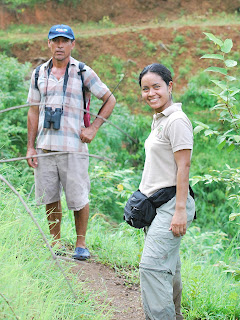 After saying good bye to our captain in El Ciruelo, we headed west away from Pedasí. The road is in very good condition all the way to Cambutal, except by the stretch between Cañas and Tonosí. The Mourning Doves were abundant along the road, and even we saw a covey of Crested Bobwhites crossing it. We arrived to Cambutal before noon and parked our car where the asphalt road ends. After asking for some directions and tips, we started to walk the dirt road to Cobachon, a little town in the coast 22 km away. The first 10 km were more or less flat, but then it became hilly and gruelling. The rain accompanied us almost all the way and we had little time because it was getting dark. Anyway, we enjoyed the beauty of the landscapes, the furious sea breaking into
After saying good bye to our captain in El Ciruelo, we headed west away from Pedasí. The road is in very good condition all the way to Cambutal, except by the stretch between Cañas and Tonosí. The Mourning Doves were abundant along the road, and even we saw a covey of Crested Bobwhites crossing it. We arrived to Cambutal before noon and parked our car where the asphalt road ends. After asking for some directions and tips, we started to walk the dirt road to Cobachon, a little town in the coast 22 km away. The first 10 km were more or less flat, but then it became hilly and gruelling. The rain accompanied us almost all the way and we had little time because it was getting dark. Anyway, we enjoyed the beauty of the landscapes, the furious sea breaking into  the rocky coast, the long and desolate beaches meeting the forested hills full of colourful crabs and the chilly streaming rivers along the way. Despite the hurry, we saw some birds on the way. A Bare-throated Tiger-Heron in the Peña Blanca river and a Black-hooded Antshrike close to the Portobelo river were the highlights. After 6.5 hours (and slightly sad, thinking that we wouldn't make it), we reached an open grassy area with a old sign in its far end, close to the beach. Only after checking it with my binoculars I realize that we reached Cobachon!!, but wait a minute... the place seemed as a ghost town... without sign of life. After 10 long minutes, we saw two kids playing in the beach and soon his smiling dad introduced himself as Daniel Saénz.
the rocky coast, the long and desolate beaches meeting the forested hills full of colourful crabs and the chilly streaming rivers along the way. Despite the hurry, we saw some birds on the way. A Bare-throated Tiger-Heron in the Peña Blanca river and a Black-hooded Antshrike close to the Portobelo river were the highlights. After 6.5 hours (and slightly sad, thinking that we wouldn't make it), we reached an open grassy area with a old sign in its far end, close to the beach. Only after checking it with my binoculars I realize that we reached Cobachon!!, but wait a minute... the place seemed as a ghost town... without sign of life. After 10 long minutes, we saw two kids playing in the beach and soon his smiling dad introduced himself as Daniel Saénz.  I immediately recognized the name... he is listed in the book Where to find birds in Panama as THE one can guide you around the place. We were lucky to find him in town. Nicely, he offered us his house and a hot dinner, quickly prepared by his wife. We talked that night about a lot of things, including the Azuero Parakeet. Soon he was telling me about Francisco Delgado, Robert Ridgely, the Englemans and many others that he guided before to Cerro Hoya. He knows many english names of birds and knows very well the behavioral aspects of the parakeet (where and when it occurs, what it eats, its calls, and so on...), and we agree to work out early the following day to look for the parakeet. The Azuero Parakeet was discovered in 1979 by Francisco Delgado and is endemic of the Cerro Hoya and surroundings in the Azuero peninsula.
I immediately recognized the name... he is listed in the book Where to find birds in Panama as THE one can guide you around the place. We were lucky to find him in town. Nicely, he offered us his house and a hot dinner, quickly prepared by his wife. We talked that night about a lot of things, including the Azuero Parakeet. Soon he was telling me about Francisco Delgado, Robert Ridgely, the Englemans and many others that he guided before to Cerro Hoya. He knows many english names of birds and knows very well the behavioral aspects of the parakeet (where and when it occurs, what it eats, its calls, and so on...), and we agree to work out early the following day to look for the parakeet. The Azuero Parakeet was discovered in 1979 by Francisco Delgado and is endemic of the Cerro Hoya and surroundings in the Azuero peninsula.  First described as a subspecies of the south american Painted Parakeet, its differences in plumage and its amazing isolation prove to be a different species. Cerro Hoya itself is an unique ecosystem at the Azuero peninsula and is protected by the national park that bears the same name. In the morning of july 21st, we started hiking along the Cobachon river, entering its valley. After an hour, we started climbing the hills looking for the flocks to appear. Soon, Daniel found the first (of many) pair of Great Green Macaws eating quietly the fruits of a nance tree (Byrsonima crassifolia). When they flew across the valley, we admired theirs long and colourful tails and blue flight feathers, contrasting with the green body... amazing! Then, Daniel saw a group of at least 12 Azuero Parakeets perched on a Higueron (Ficus sp.) that flew directly toward us and perched very close...WOW... the Azueros right in front of us and I was so excited watching them that I did not manage to take photos in that moment. What a beautiful bird, hard to describe... and so unique! We found later a different group eating from the fruiting higuerones and guarumos (Cecropia sp.) and I managed to take some blurry photos, but at least the bird is recognizable. The experience revived us since, in spite of our weariness, we descended from the hill, packed our things, say goodbye to the Saénz family and tackled the return, arriving to Cambutal at 7 p.m.
First described as a subspecies of the south american Painted Parakeet, its differences in plumage and its amazing isolation prove to be a different species. Cerro Hoya itself is an unique ecosystem at the Azuero peninsula and is protected by the national park that bears the same name. In the morning of july 21st, we started hiking along the Cobachon river, entering its valley. After an hour, we started climbing the hills looking for the flocks to appear. Soon, Daniel found the first (of many) pair of Great Green Macaws eating quietly the fruits of a nance tree (Byrsonima crassifolia). When they flew across the valley, we admired theirs long and colourful tails and blue flight feathers, contrasting with the green body... amazing! Then, Daniel saw a group of at least 12 Azuero Parakeets perched on a Higueron (Ficus sp.) that flew directly toward us and perched very close...WOW... the Azueros right in front of us and I was so excited watching them that I did not manage to take photos in that moment. What a beautiful bird, hard to describe... and so unique! We found later a different group eating from the fruiting higuerones and guarumos (Cecropia sp.) and I managed to take some blurry photos, but at least the bird is recognizable. The experience revived us since, in spite of our weariness, we descended from the hill, packed our things, say goodbye to the Saénz family and tackled the return, arriving to Cambutal at 7 p.m.  That night we got some analgesic and antiinflamatory pills... every single muscle fiber was hurting. I still have a swollen ankle and Gloriela barely moves... but we are happy with the experience. After all, no pain no birds.
That night we got some analgesic and antiinflamatory pills... every single muscle fiber was hurting. I still have a swollen ankle and Gloriela barely moves... but we are happy with the experience. After all, no pain no birds.
Well, are you ready to look for the Azuero Parakeet at Cobachon? Here are some tips:
1. Announce that you are going: Cobachon only has three families, and maybe only Daniel can guide you around, so it is better to count with him. Leave a message with Radio Peninsula (995-4214).
2. Hire a boat in Cambutal: the ride is more or less one hour and they charge you around a hundred dollars the round trip. Ask for the service in the Casa González (where the asphalt road ends).
3. If you want to take the scenic road, then plan it with time: the topography is difficult and the road does not have any sign. The locals will tell you that it can be walked in 5 hours, but they are used to walk long distances and they know shortcuts through the beaches to skip the hills. The road climbs eight hills, the third one being specially demanding. Ask everyone you cross in the way for directions, because you have to turn aside of the road while climbing the sixth hill (be kept to the coast)
4. Read all you can about the road and the place (Where to find birds in Panama, Almanaque Azul -spanish only-, the web, and so on...).
Happy birding!











mi lindo cobachon <3
ReplyDelete